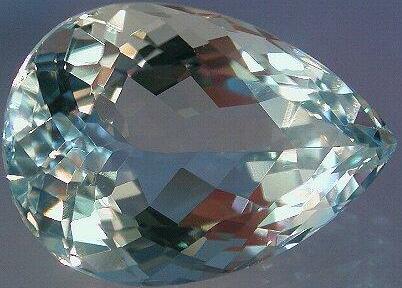Aquamarine is a member of the beryl family of gemstones that
is usually colored various shades of blue/green or may appear as either light
green or even as dark blue stones rivaling sapphire in color. The mineral is a beryllium aluminum
cyclosilicate with the formula Be3Al2(SiO3)6. Terminated crystals of beryl are relatively
rare, but are known to occur. The stone
has a value as a gemstone, and is a common ore of the metal beryllium. In the case of aquamarine a small amount of
iron that causes crystal defects in the crystal is the cause of its color. The mineral beryl because of impurities in
the crystal does occur in several different colors including green blue, yellow,
red and white.
 |
| Aquamarine in a matrix of feldspar crystals.and other minerals including schorl the black crystal in the middle of the specimen. Photo by Rob Lavinsky |
The colors of aquamarine can range from light blue like that
of the sky to a deep blue of the sea.
The darker the color the higher the price some aquamarines can sell for
as much as $2,000 per caret although lighter stones only fetch a few dollars
per carat. The stone itself is
fascinatingly beautiful with much appeal to women all over the world because it
can complement or eye color. For
creative gemstone cutters it is an inspiration because of its ability to be cut
in so many designs and still keep its beauty.
 |
| A water etched crystal of aquamarine from Brazil Photo by Rob Lavinsky |
Aquamarine is epitomized by its blue color, and the deeper
blue the color the more expensive the stone making it one of the most popular
stones rivaling at times its more expensive cousin emerald that also belongs to
the beryl family. The stone is hard
enough at Mohs hardness of 7.5 to 8 so it can be used in most types of jewelry
making it almost as popular as the classic stones emerald, ruby and
sapphire. In reality aquamarine is
related to the emerald, but unlike its more famous cousin it usually free of
flaws. One flaw that is sometimes seen
in aquamarine is long thin tubes that sometimes lend to its beauty in the form
of chatoyancy forming tiger eyes or more rarely a star stone much like star
sapphire. Both forms of the stone command
very high prices.
 |
| An example of a pear shaped aquamarine faceted gem. Photographer Unknown |
The color of aquamarine is caused by ions of iron causing
crystal defects in the mineral beryl that is normally clear that is called
goshenite my mineralogists because its type locality is in Goshen,
Massachusetts were it is found in lithium bearing pegmatites. Aquamarine can range from a pale blue to a
strongly colored sea blue. In some
aquamarines you can see a light greenish simmer that is a typical feature of
the stone. Thee most prized color
however is a pure clear blue transparent stone bringing out the transparency
and shine of this magnificent stone.
Aquamarine Gemstones for You
ReplyDeleteaquamarine stone called aquamarine possesses best color which will nature offers us all.
ReplyDelete